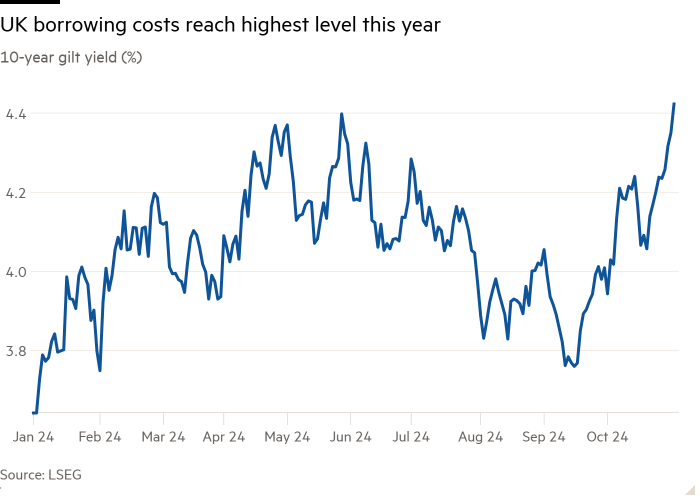UK borrowing costs hit highest level this year after Budget

Unlock the Editor’s Digest for free
Roula Khalaf, Editor of the FT, selects her favourite stories in this weekly newsletter.
UK borrowing costs climbed on Thursday, touching their highest levels of the year, as bond investors worried about the additional borrowing that chancellor Rachel Reeves set out in the Budget.
The yield on the 10-year gilt rose 0.06 percentage points to 4.42 per cent, while the two-year yield edged up 0.08 percentage points to 4.39 per cent.
The moves followed volatile trading on Wednesday, when the bond market reversed an initially positive reaction to Labour’s first Budget in 14 years as the scale of the government’s additional borrowing became clear.
Analysts said the market was responding to an increase in borrowing of £28bn a year over the parliament, after what the Office for Budget Responsibility called “one of the largest fiscal loosenings of any fiscal event in recent decades”.
“The Budget sounded OK with its well-flagged new fiscal rules . . . but the amount of extra borrowing in the future still caught the market by surprise,” said Michael Metcalfe, head of macro strategy at investment manager State Street.
“[It’s] amazing how the narrative can change in 30 minutes,” he added.

Figures from the Debt Management Office also showed debt sales were likely to reach £300bn in the current fiscal year, up from the previous estimate of £278bn and slightly above investors’ expectations.
Mohit Kumar, a fixed-income analyst at Jefferies, noted on Thursday that “the immediate concern for the market would be fiscal expansion funded by long-dated issuance”.
The OBR said that the additional borrowing had not been fully expected by investors and was likely to result in higher interest rates over the next few years.
JPMorgan’s Allan Monks said Labour’s decision to “tax, borrow and spend on a large scale” would push up short-term growth and inflation.
As a result, “the Budget changes the calculus [on rate cuts], and increases the odds the Bank will stick to a cuts of once per quarter”.
Swaps markets have moved to price in a slower rate of cuts over the coming year. Investors now expect three or four-quarter-point rate cuts over the next 12 months. Before the Budget, they anticipated four or five.
Despite the market concerns over borrowing, several investors drew a contrast between the reaction to Reeves’ plans and the gilts crisis sparked in 2022 by Liz Truss’s ill-fated “mini” Budget — particularly given the chancellor’s pledge to eliminate the deficit on day-to-day spending in three years.
“There are no reasons for us to question the fiscal credibility in the UK,” said Pimco economist Peder Beck-Friis. “The government intends to bring the primary deficit into a large surplus, for the first time since the early 2000s.” Government debt “may not fall in coming years, [but] it is unlikely to rise dramatically either”.
#borrowing #costs #hit #highest #level #year #Budget





